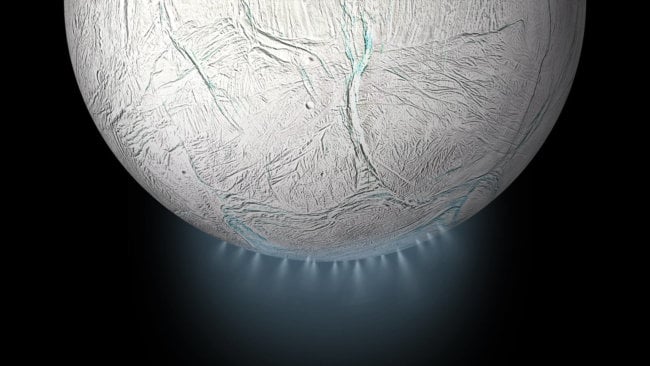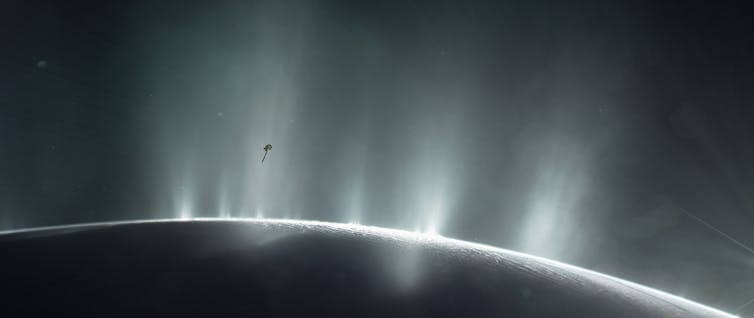
Recently we said goodbye with the spacecraft “Cassini”, which after 13 years of loyal service to orbit Saturn and its satellites dropped right in the deep atmosphere of the giant planet. The reason this Grand final was a warning of the possibility that Cassini will crash into one of Saturn’s moons — in particular, Enceladus.
Enceladus is unique for its geysers and curtain of the inner ocean. Today, this tiny, icy moon is considered to be a potential habitat for life, so we could not let her be contaminated by the spacecraft Cassini. A new study published in Nature Astronomy, suggests that this ocean existed under the surface of Enceladus in a very long time — long enough to create conditions for the development of life.
The geysers of Enceladus is the emission of salty water-ice mixtures with traces of carbon dioxide, ammonia, methane and other hydrocarbons that erupt from cracks in the South polar region of Enceladus. It is because of these geysers scientists have decided that the Enceladus should be a subsurface ocean and that ocean is active (convective). Subsequent observation showed that the emissions were present hydrogen, which led to the additional conclusion that hydrothermal activity chemical reactions caused by the interaction of water and rocks. But scientists are unable to explain what heat source could cause this activity.
After further observation, the mystery of the missing source of heat only intensified. The geysers are associated with the so-called “tiger stripes” — a set of four parallel faults on the surface, a length of 100 kilometers and a depth of 500 meters. The temperature of these bands higher than the rest of the ice crust, so it was assumed that they must be cracks in the ice. In the area of the tiger stripes are almost no impact craters, so they must be very young, about a million years. Any model that could explain the source of heat, will also have to take into account its focused — the ocean of the world, but why is only active South polar region?

For several years scientists prefer the explanation of “tidal heating” is the result of interaction of bodies of planetary size. For example, the tidal interaction with our own moon is responsible for the ebb and flow of water on Earth. Enceladus is in an orbital resonance with the moon Dione, which affects the shape of the orbit of Enceladus around Saturn. But this influence is not enough to explain the power required to maintain the geysers in the active state on the order of 5 GW. It would be enough for a city the size of St. Petersburg.
Porous core
Scientists closer to solving the puzzle, when I looked at the internal structure of Enceladus. This moon low enough density that it consists mainly of ice with a small solid core. Thought so many years since “Voyager 2” made the first images of Enceladus and identified the radius and then the volume. The gravitational pull of Enceladus acting on Cassini, allowed to estimate the mass of the moon and deduced a value of the density of the body. Measurements by Cassini have also shown that the nucleus has low density, which allows to conclude that the porous nature of the nucleus, with ice-filled pores.
A new series of calculations fills the pores of the nucleus rather with water, not ice, because of tidal forces associated with water in the pores is more than enough to explain how heat is generated of Enceladus. A wonderful model that explains not only the porosity of the core, and its permeability (how easily it passes through the liquid) and strength (whether it will crack when the liquid passes?).
The combination of all these parameters in one equation to allow it to creating elegant models of heat flow within Enceladus.

The authors create a three-dimensional image of where and when the heat of tidal movements within the porous spaces is transmitted to the subsurface ocean. Heat distribution the kernel is not uniform, but rather in the process associated narrow upwelling predominantly in the South pole. And since the sources of heat (the temperature reaches 85 degrees Celsius) so focused next to them should be increased hydrothermal activity, explaining the hydrogen in the eruption.
Finally, the striking observation that can be made in the process of analyzing this model is that the amount of heat generated internal tide, enough to maintain a subsurface ocean of Enceladus over billions of years. Born another question: what does it all mean for life on Enceladus? The warmer the oceans, the existing several billion years, would be a perfect cradle for life on Earth, it took her only 640 million years to go from the form of microbes in mammals. Unfortunately, the Enceladus can be quite young — he could have formed only 100 million years ago. Is that enough time for life?
Possible. Most likely, life on Earth was formed over several hundred million years in much more severe conditions heavy bombardment. But then it took another 3500 million years, to extend the area of its influence. Maybe this will be the future of Enceladus. Maybe this moon will become a planet of the apes, and planet of the mermaids?
Ocean of Enceladus may be sufficiently ancient that it was life
Ilya Hel